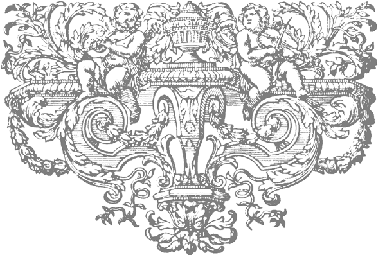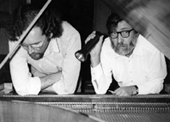J O H N B A R N E S
A TRIBUTE TO MY TEACHER AND MENTOR
by
Grant O'Brien
Good times with John Barnes
A personal recollection
and a reminder that 2018 marks the 20th anniversary of John's death.
John Barnes was many things. He was an excellent scholar. He was a superb craftsman. He was an ingenious restorer with the highest respect for the objects that he was restoring. He was incredibly generous with his knowledge and expertise. He was exceptionally patient with novices who did not have the advantage of his wealth of experience and erudition. He was well-read and interested in the theatre, the arts, and world and local politics. But the thing that I found most endearing about John was his sense of humour and the impishly wicked twinkle in his eye.
It was a great privilege to work beside John in his tiny workshop. Of course I learned a tremendous amount from him through the daily contact that we had. I absorbed information from him like a sponge. He knew so much! I suppose the over-riding thing I learned from him was that, when it came to carrying out repetitive jobs, like making jacks for example, it was more than worthwhile to make jigs to help to do these jobs. It greatly speeded up the job, and it meant that the job was done with a much greater precision and consistency than if each job was done separately in different operations. We invented jigs for tapering the ends of tuning pins, for drilling the holes for the axel pins in jacks, for cutting the tongue slots in jacks, for making and punching the quill slots in jacks, for making registers, and so on and so on.
John was, among the many aspects of his interests, very keen to understand not only the practicalities of tuning, but also the theory behind tuning. This resulted in John's suggestion for a tuning system that was particularly apt for the performance of Bach's monumental series of pieces in all of the major and minor tonalities - the famous 48 preludes and fuges. This was published among his many other publications (see 1979a). Here is a picture of John tuning his Dulcken harpsichord in the former family sitting room in East Castle Road:
John tuning his Dulcken single-manual
harpsichord
John always strove to understand the historical principles that the makers of the past used to design and construct their instruments. One of the guiding principles that he followed all through his career was to treat the evidence that he found in and on the instruments themselves as absolute, and he had a considerable contempt for many of the modern theories and ideas not based on sound evidence from the building practices of the historical makers. So he treated the modern accretions that he found on many of the instruments that he restored with considerable contempt. One of the most common of these was the addition of ‘soundbars’ under the soundboard in the style of the revival harpsichords that were then still being built, basically in the piano tradition. John called these ‘stifle bars’ because of their obvious effect on the sound of the instruments which they afflicted. He gave the name 'pianochords' to the modern revival harpsichords with their piano-style soundboard barring, steel framing, heavy piano-style keyboards, bevelled cheek-pieces like Viennese fortepianos, etc. John was interested only in getting back to the historical principles used by the original makers from the sixteenth to the eighteenth centuries. So far as John was concerned 'old was best' and, although, he was knowledgeable about modern materials and techniques, he also knew that the old methods and materials had produced superb results which had, by their very survival through to the present day, lasted perfectly well through the centuries. His principle was - try the historical method first. It will almost certainly work well. If it really doesn't, then think again perhaps.
I was very lucky to work beside John Barnes. Shortly after I was able to buy the piano by Ignaz Heinrich, Ölmutz, Bohemia, c. 1825 for the Russell Collection where we both had the chance to look at it together.
Grant and John looking at a 'new' instrument at the Russell Collection
But our daily contact also meant that I came to know his sense of humour as well. We had a lot of fun together as well as working very hard. The following is just one example of the fun that John and I had together.
This particular instrance arose because of one of the instruments that passed through the workshop while I was working with John. This was the so-called 'Ham House Ruckers’ fake harpsichord belonging to the Victoria and Albert Museum. This was an exceptionally interesting early English double-manual harpsichord probably made in the period around 1710-1720. And as with so many other interesting harpsichords, this one had been faked to look like a Ruckers instrument. It had silk-screened (not block-printed) ‘Ruckers’ papers, an imitation marble outer case decoration, a re-casting of an Andreas Ruckers rose with the initials altered to ‘IR’, a fake ‘Ruckers’ soundboard painting, etc. The instrument had been restored in 1894 by Arnold Dolmetsch and, as with so many of Dolmetsch’s 'restorations', there were the inevitable lead weights added to the jacks and keylevers and ‘stifle bars’ added under the soundboard in a kind of neo-piano style. By the time John came to restore the Ham House ‘Ruckers’ he had seen so many of Dolmetsch’s ‘restorations’ which included these stifle bars that it was no surprise to him to find them in this instrument as well . Indeed, John almost exuded a feeling of genuine satisfaction when he opened the instrument and his worst suspicions were confirmed!
The result was the accompanying limerick (inscribed by Pat Jones - then Pat Dawe) which I composed for John’s birthday shortly after the ‘Ruckers’ was opened. I think this will give some idea of John, of his sense of humour and of the humour that he inspired.

We all hope that the day of stifle bars is over. But I found Dolmetsch's stifle bars during the restoration of the Franco-Flemish harpsichord discussed elsewhere on this site.
Return to section on John Barnes


